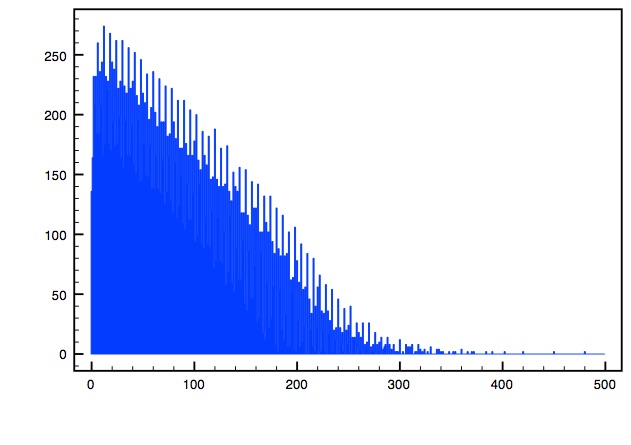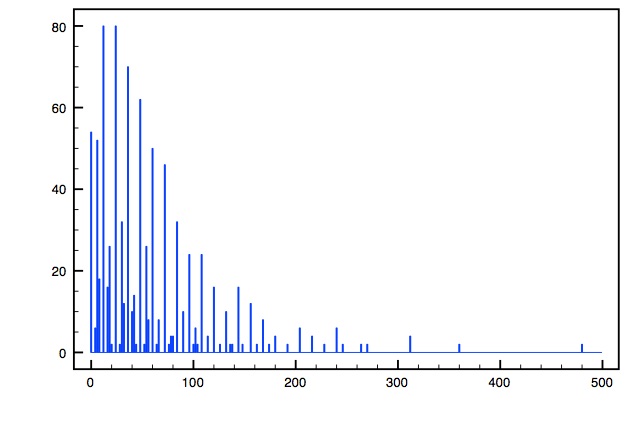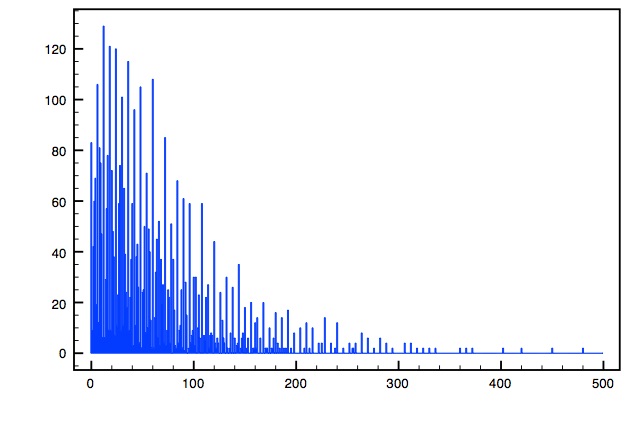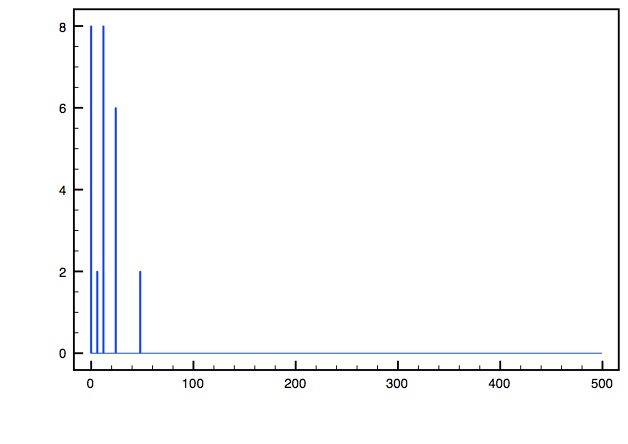
Hodge Number Tables
1989 Results (Gepner models)
These are scanned pdf files of the Gepner model simple current Hodge scan made in 1989 in collaboration with Shimon Yankielowicz.
The scan covers all simple current invariants that can be obtained by multiplying the modular matrices of simple current MIPFs defined by a single current. These currents were selected at random. Up to eight
single current matrices are multiplied.
All spectra have at least N=1 supersymmetry and E6 or SO(10) gauge symmetry.
The following paper contains a summary of the result, with spectra organized according to their Hodge numbers (and other data). These tables only contain the (2,2) spectra.
2008 Results (Gepner models)
These are files from a scan done in 2008. Unlike the 1989 results these are not based on random selection, but on a complete enumeration of all the MIPFs.
There are 168 files of type “.hodge_summary”, one for each Gepner model combination.
Each file contains lines of the form
nr. 5 [found as nr. 3]: 10 x (40,4,252,8,8,4,4,1)
These numbers are respectively a sequential label, a label indicating the original order in which these MIPFs were found, and the multiplicity. Typically, the multiplicity is 1, in other words every MIPF generates a distinct spectrum. If low-level factors (in particular k=1 and k=2) occur in the tensor product there may be degeneracies.
The numbers between parentheses are respectively the hodge numbers h11, h12, the number of singlets occurring in a heterotic spectrum, the number of additional (i.e. in addition to E6 vector bosons in a heterotic spectrum in the left or right algebra (if the left resp. the right algebra is used as a bosonic sector in a heterotic string), the number of left- and right supersymmetries, and an integer indicating if the MIPF is symmetric (1) or not (0).
In a few cases (namely (1,1,1,1,1,1,1,1,1), (1,1,1,1,1,1,4) and (1,1,1,1,1,4,4)) the total number of asymmetric MIPFs was too large to enumerate, and in this case a randomized scan was done, allowing only a limited number of “discrete torsion” values for each simple current group. In all cases those scans were extensive enough to ensure that most likely nothing was missed.
Complete scans will always display exact mirror symmetry.
Additional files in the downloaded directory are explained below, under “Summary”.
2008 Results (Free Fermion Models)
These are files from a scan done in 2008, in collaboration with M. Lennek and E. Kiritsis.
Most of these runs were done by M. Lennek.
Free Fermion Hodge number files
There are 62 files, one for each realization of world-sheet supersymmetry. The format is as above, except that only symmetric MIPFs are considered here, and the last number indicating
(a)symmetry is therefore not listed. Included in this directory are the original kac input files, defining the word-sheet supersymmetry projection.
Summary
We can distinguish all the aforementioned spectra on the basis of several criteria:
-
 Euler numbers 2 x (h11-h12)
Euler numbers 2 x (h11-h12) -
 Hodge pairs h11, h12
Hodge pairs h11, h12 -
 Hodge triplets h11, h12, singlets
Hodge triplets h11, h12, singlets -
 Hodge quartets h11, h12, singlets and extra (in addition to E6) vector bosons
Hodge quartets h11, h12, singlets and extra (in addition to E6) vector bosons
In addition, it is useful to consider “Higgsed triplets”, where h11, h12 and the difference between singlets and vector bosons are considered. The idea is that some spectra differ only because a vector bosons has absorbed a singlet to acquire mass.
The total number for each of these kinds of spectra are as follows:
Symmetric Gepner model MIPFs:
-
 Distinct Euler numbers: 113
Distinct Euler numbers: 113 -
 Distinct Hodge Pairs: 868
Distinct Hodge Pairs: 868 -
 Distinct Hodge Triplets: 1767
Distinct Hodge Triplets: 1767 -
 Distinct Spectra (Quartets): 1785
Distinct Spectra (Quartets): 1785 -
 Distinct Spectra (Higgsed): 1681
Distinct Spectra (Higgsed): 1681
Symmetric plus asymmetric Gepner model MIPFs:
-
 Distinct Euler numbers: 115
Distinct Euler numbers: 115 -
 Distinct Hodge Pairs: 906
Distinct Hodge Pairs: 906 -
 Distinct Hodge Triplets: 1981
Distinct Hodge Triplets: 1981 -
 Distinct Spectra (Quartets): 2013
Distinct Spectra (Quartets): 2013 -
 Distinct Spectra (Higgsed): 1885
Distinct Spectra (Higgsed): 1885
Free Fermionic MIPFs:
-
 Distinct Euler numbers: 9
Distinct Euler numbers: 9 -
 Distinct Hodge Pairs: 26
Distinct Hodge Pairs: 26 -
 Distinct Hodge Triplets: 363
Distinct Hodge Triplets: 363 -
 Distinct Spectra (Quartets): 382
Distinct Spectra (Quartets): 382 -
 Distinct Spectra (Higgsed): 284
Distinct Spectra (Higgsed): 284
Symmetric, asymmetric Gepner MIPFs combined with free fermions:
-
 Distinct Euler numbers: 115
Distinct Euler numbers: 115 -
 Distinct Hodge Pairs: 906
Distinct Hodge Pairs: 906 -
 Distinct Hodge Triplets: 2306
Distinct Hodge Triplets: 2306 -
 Distinct Spectra (Quartets): 2373
Distinct Spectra (Quartets): 2373 -
 Distinct Spectra (Higgsed): 2134
Distinct Spectra (Higgsed): 2134
Note that
-
-Distinct spectra are almost completely distinguished by triplets
-
-There is some evidence for a Higgs relationship between some spectra
-
-Free fermions add nothing to the list of Hodge pairs
The additional files in the Gepner model directory are
-
-All_Gepner_symmetric
-
-All_Gepner_asymmetric
-
-All_Fermionic
These file contain the raw data from all hodge_summary files, with identical lines removed, and order according to |h11-h12| (the first entry on each line).
Furthermore there are files Euler, Hodge, Quartets, Triplets containing the lists of the first four spectrum types explained above for all Gepner models. The first entry in the latter three files is h11-h12, by which all entries are ordered. For each of these four files there is also one with “_symmetric” and “_total” attached to their names. They contain the same information for symmetric Gepner MIPFs only, and for the total, all Gepner MIPFs and fermionic MIPFs combined.
Comparison with Calabi-Yau and Landau-Ginzburg data
The CY and LG data are from the home page of Max Kreuzer.
There are 30108 hodge pairs from “reflexive polyhedra”. The set of 4370 LG Hodge
pairs we consider is a combination of the three classes listed, namely “untwisted models”,
“abelian orbifolds” and “discrete torsion”.
So we consider four classes, denoted as CY, LG, Gepner, Free Fermion.
Total number of CY hodge pairs: 30108
Total number of LG hodge pairs: 4370
Total number of Gepner hodge pairs: 906
Total number of Free Fermion hodge pairs: 26
The overlaps between these sets are as follows
Free Fermion overlap
All contained in Hodge
Not contained in CY: 16
All contained in LG
Hodge overlap
Not contained in Free Fermion: 880
Not contained in CY: 112
All contained in LG
LG overlap
Not contained in Free Fermion: 4344
Not contained in CY: 200
Not contained in Hodge: 3464
CY overlap
Not contained in Free Fermion: 30098
Not contained in LG: 25938
Not contained in Hodge: 29314
This means that the Free fermion class is fully contained in the Gepner class,
which in its turn is fully contained in the LG class. However, the LG class is not fully contained in the CY class.
This is graphical comparison between the classes. On the horizontal axis is the number of families, the absolute value of h11-h12. On the vertical axis we put the total number of distinct Hodge pairs for a given number of families.




Free Fermion
Gepner
LG
CY